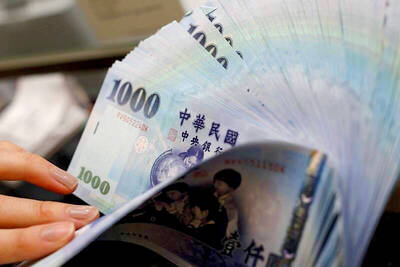Taiwan must accelerate progress in constructing wireless infrastructure in its major cities to catch up in the worldwide trend toward having wireless Internet connections available everywhere, officials and industrialists said yesterday.
They said expanding the infrastructure would help create huge business potential for the industry.
"The prevalence of wireless broadband Internet access will stimulate local companies to develop compatible mobile devices, which is expected to draw orders from overseas since many countries are keen to construct so-called `wireless cities,'" said Jason Chen (陳立生), country manager of Intel Microelectronics Asia Ltd's Taiwan Branch.
Finland, the US, Japan and South Korea are countries that are speeding up promotion of wireless cities, Chen said at a forum.
The South Korean government has pumped huge resources into wireless infrastructure as a way to develop the nation's flat-panel display industry, he said.
Japan's government plans to have Tokyo to become the first city where WiMax -- a technology that can send high-speed broadband signals over a citywide area -- is available everywhere, while in Finland, Nokia Oyj recently announced it would work with Intel to develop handsets that operate using WiMax, he said.
In comparison, wireless Internet connection is only available in small areas of certain cities in this country. Taipei City has the largest coverage, which includes the Xinyi District and 30 mass rapid transit (MRT) stations.
The Taipei City Government plans to bring the service to 50 percent of the population by the end of this month and 90 percent by the end of next year.
Although Taipei has the most hotspots in the nation, the utilization rate is low. According to city government's estimates, on weekdays an average of 450 users access the wireless connection a day in and near the MRT stations, and about 200 people make use of the service in the Xinyi District.
Expanding the hotspots into a hotzone is key to boosting user traffic, as well as attracting more content providers to develop more value-added services, Chen said.
However, networks provided by different telecom carriers should be integrated to allow users access the wireless connections without going through the hassle of applying for different accounts, he said.
Taipei Deputy Mayor King Pu-tsung (
But much more has to be done, Chen said, adding that the largest barrier remains regulations, since the bandwidth is still controlled by the government.
Fortunately, the government has agreed to loosen regulations within six months, said Wong Pu-shan (翁樸山), chairman of the Electrical and Electronic Manufacturers' Association's (電電公會) communications industry alliance.
"The industry is expected to take off in 2008, when various form of communications, including sound, text, image and motion pictures can be integrated in one gadget wherever people go," Wong said.

Merida Industry Co (美利達) has seen signs of recovery in the US and European markets this year, as customers are gradually depleting their inventories, the bicycle maker told shareholders yesterday. Given robust growth in new orders at its Taiwanese factory, coupled with its subsidiaries’ improving performance, Merida said it remains confident about the bicycle market’s prospects and expects steady growth in its core business this year. CAUTION ON CHINA However, the company must handle the Chinese market with great caution, as sales of road bikes there have declined significantly, affecting its revenue and profitability, Merida said in a statement, adding that it would

MARKET LEADERSHIP: Investors are flocking to Nvidia, drawn by the company’s long-term fundamntals, dominant position in the AI sector, and pricing and margin power Two years after Nvidia Corp made history by becoming the first chipmaker to achieve a US$1 trillion market capitalization, an even more remarkable milestone is within its grasp: becoming the first company to reach US$4 trillion. After the emergence of China’s DeepSeek (深度求索) sent the stock plunging earlier this year and stoked concerns that outlays on artificial intelligence (AI) infrastructure were set to slow, Nvidia shares have rallied back to a record. The company’s biggest customers remain full steam ahead on spending, much of which is flowing to its computing systems. Microsoft Corp, Meta Platforms Inc, Amazon.com Inc and Alphabet Inc are

RISING: Strong exports, and life insurance companies’ efforts to manage currency risks indicates the NT dollar would eventually pass the 29 level, an expert said The New Taiwan dollar yesterday rallied to its strongest in three years amid inflows to the nation’s stock market and broad-based weakness in the US dollar. Exporter sales of the US currency and a repatriation of funds from local asset managers also played a role, said two traders, who asked not to be identified as they were not authorized to speak publicly. State-owned banks were seen buying the greenback yesterday, but only at a moderate scale, the traders said. The local currency gained 0.77 percent, outperforming almost all of its Asian peers, to close at NT$29.165 per US dollar in Taipei trading yesterday. The

The US overtaking China as Taiwan’s top export destination could boost industrial development and wage growth, given the US is a high-income economy, an economist said yesterday. However, Taiwan still needs to diversify its export markets due to the unpredictability of US President Donald Trump’s administration, said Chiou Jiunn-rong (邱俊榮), an economics professor at National Central University. Taiwan’s exports soared to a record US$51.74 billion last month, driven by strong demand for artificial intelligence (AI) products and continued orders, with information and communication technology (ICT) and audio/video products leading all sectors. The US reclaimed its position as Taiwan’s top export market, accounting for